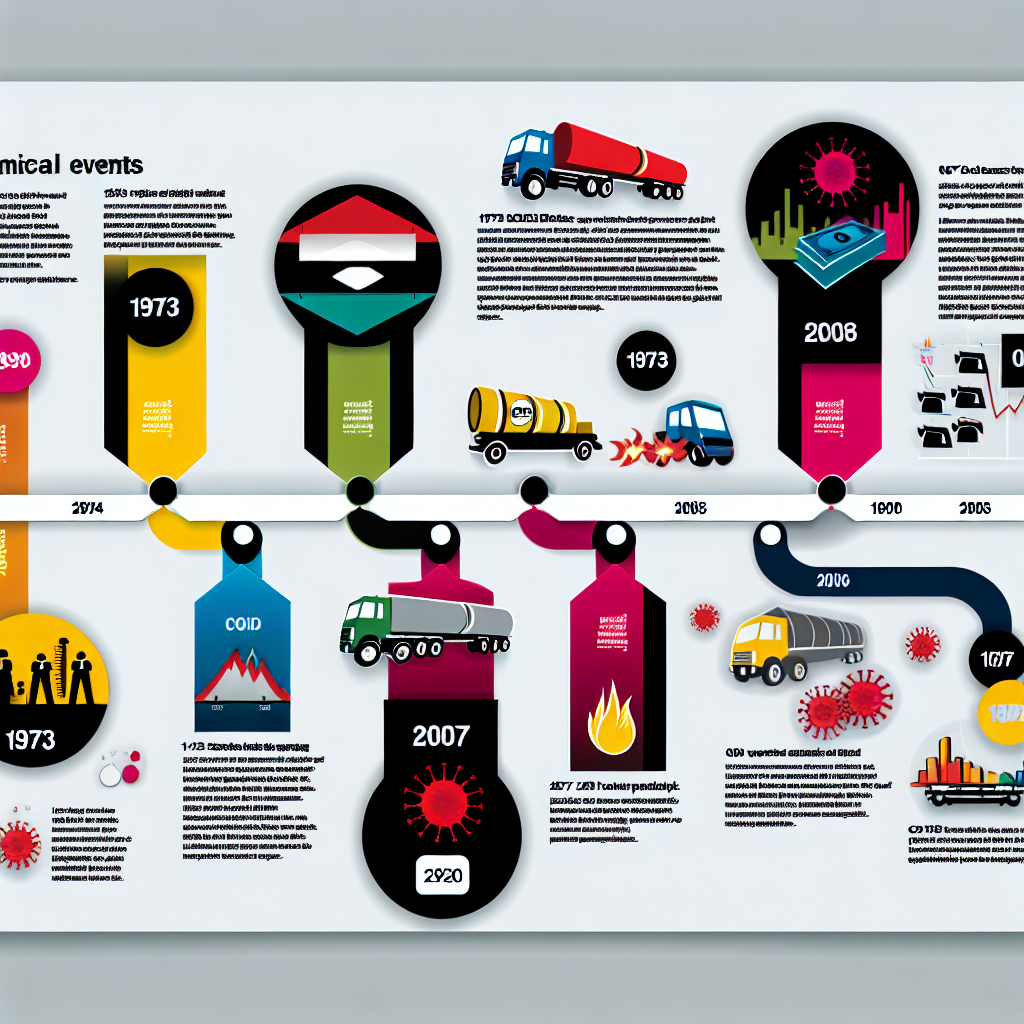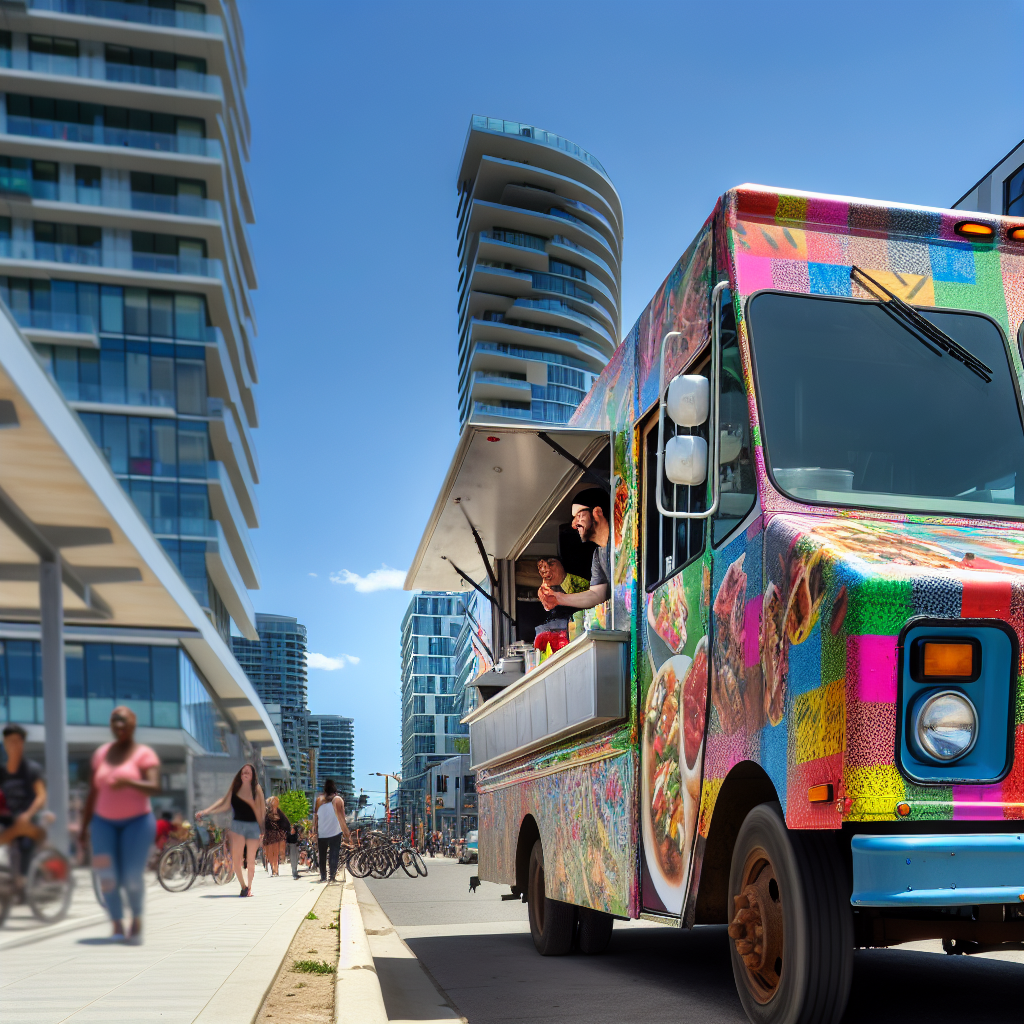The food truck industry, vibrant and resilient, has not remained untouched by the ripples of historical uncertainties that have ebbed and flowed through the freight market. Events such as the 1973 OPEC oil embargo, which drastically reshaped fuel prices and availability, have left an indelible mark on how businesses evaluate their operations. Similarly, the market crashes over the decades have compelled food truck operators to navigate a maze of fluctuating costs and consumer behavior.
Just as freight companies have responded to these upheavals with innovative strategies and adaptations, food truck businesses grapple with the same challenges, recognizing that uncertainty is an inherent part of their landscape. The interplay between these historical events and the current freight market landscape underscores the need for food truck entrepreneurs to remain adaptable, drawing lessons from the past to inform their future strategies in a world where uncertainties are a constant companion.
Major Historical Uncertainties Affecting the Freight Market
Understanding the historical uncertainties that have impacted the freight market helps food truck operators navigate today’s challenges. Two pivotal events shape this landscape: the OPEC oil embargo of 1973 and the financial crisis of 2007.
OPEC Oil Embargo (1973)
The OPEC oil embargo commenced in October 1973, drastically reshaping energy markets. Oil prices quadrupled, surging from roughly $3 to nearly $12 per barrel within a year. This sudden increase in fuel prices sent shockwaves through the freight industry, leading to operational cost escalations for transportation companies. The embargo revealed the freight sector’s vulnerability to geopolitical factors affecting oil supply, highlighting how fluctuations in diesel prices can impact logistics costs and ultimately consumer prices.
2007 Financial Crisis
Fast forward to 2007; the global economy faced another shock, this time from a financial crisis that would have profound implications for the freight industry. In that year, logistics costs surged by 7%, driven largely by rising fuel prices that saw diesel nearing $5 per gallon as the economy slowed. The trucking sector registered a decline in tonnage, reflecting reduced demand and subsequent operational adjustments. In 2007 alone, nearly 2,000 trucking companies closed their doors, leading to capacity reduction in the industry.
This crisis also triggered significant spikes in food prices worldwide. Average prices for staples like rice and wheat soared due to a combination of factors, including rising oil prices and adverse weather conditions affecting crops. As freight costs increased, food truck operators faced the compounded challenge of managing their overhead while catering to a consumer base sensitive to prices.
Lessons for Food Truck Owners
The historical context of market uncertainty, driven by events like the OPEC embargo and the 2007 financial crisis, underscores the necessity for food truck entrepreneurs to stay agile. Fuel price volatility continues to pose a risk, urging operators to proactively implement strategies that enhance efficiency, such as investing in more fuel-efficient vehicles or optimizing delivery routes.
In conclusion, the freight market’s history of uncertainties teaches food truck operators the importance of resilience. By understanding these past events, they can better prepare for future fluctuations influenced by geopolitical tensions and economic downturns.

Adapting to Market Uncertainties: Lessons from the Freight Industry
As the food truck industry navigates the complexities of market uncertainties, it can draw valuable insights from the freight sector’s strategies for resilience and adaptability. Here are several approaches food truck operators can consider:
1. Embrace Technological Innovations
The freight industry has integrated technologies such as GPS tracking and real-time data analytics to optimize routes and enhance efficiency. Food truck operators can similarly adopt mobile ordering apps and GPS tracking to inform customers about their locations, thus minimizing wait times and improving customer satisfaction while streamlining operations.
2. Diversify Revenue Streams
Just as freight companies diversify their services to mitigate risks, food truck operators should consider expanding their offerings. Providing catering services, collaborating with local businesses, and participating in food festivals can create additional income streams and broaden customer reach.
3. Build Strong Community Networks
Establishing robust relationships within the community can provide support during uncertain times. By engaging with local businesses and participating in community events, food truck operators can foster a network that encourages resilience and shared resources.
4. Adapt to Regulatory Changes
Both freight and food truck industries navigate complex regulatory environments. Staying up-to-date with local regulations, obtaining necessary permits, and ensuring compliance can prevent operational disruptions and maintain continuous service without fines.
5. Implement Flexible Operational Strategies
Similar to how the freight industry adjusts operations based on demand fluctuations, food truck operators can adopt flexible strategies. Modifying menus seasonally, adjusting operating hours, and exploring new service locations can help maintain steady revenue streams.
By integrating these strategies, food truck operators can enhance their adaptability to market uncertainties, drawing upon valuable lessons from the freight industry’s experience in facing similar challenges. This proactive approach not only prepares them for uncertainties but also positions them for growth in an evolving market.
Food Truck Industry Success Rates Amid Economic Uncertainty
The food truck industry has shown impressive resilience and growth over the past decade, evolving into a significant player within the broader food service market. Valued at approximately $2.8 billion in 2025, the food truck sector has experienced an annual growth rate of 13.2% during the past five years (source).
Profitability and Operational Costs
Entrepreneurs entering the food truck business face varying startup costs. The average purchase price for new food trucks is around $108,500, while used trucks are approximately $46,800. On average, food trucks generate $346,000 in annual revenue, with profit margins typically resting between 3% and 8% (source). Many well-managed food trucks reach net profitability within 6 to 18 months after launching, demonstrating a favorable return on investment when effectively operated (source).
Despite this positive outlook, economic uncertainties have impacted operational costs. Over the last five years, operational costs have risen by 7.9%, driven by inflationary pressures and escalating fuel prices (source). Regulatory challenges further complicate the landscape; the average cost of permits and compliance measures is now around $28,276, often resulting in delays that can inhibit timely service delivery for new operators (source).
Adaptations and Challenges
As the market matures, we see a trend toward digital integration among food truck owners. About 90% now utilize digital tools to streamline their operations, with many shifting to alternative point-of-sale systems to better manage customer engagement (source). Additionally, approximately 31% of food truck operators expanded into catering markets to diversify their service offerings, reflecting an adaptability that may safeguard them against economic fluctuations (source).
Seasonal demand fluctuations and persistent labor shortages remain key challenges. Variable demand through colder months can affect revenue streams, especially when combined with increased fuel and operational costs. Additionally, approximately 30% of food truck businesses reported cash flow challenges during off-peak periods due to lean staffing models (source).
Conclusion
While opportunities for growth abound amid economic uncertainties, food truck operators must leverage strategic planning and adaptability to navigate complexities effectively. Understanding these dynamics is essential for achieving long-term success in the food truck market, which is undeniably being shaped by external economic factors and evolving consumer expectations.
In conclusion, the journey of the food truck industry underscores the paramount importance of adaptability in navigating the uncertainties that lie ahead. As historical events have shown, many industries, especially the freight market, have faced crises that challenged their very foundations. Food truck operators can benefit immensely by learning from these lessons, adopting flexible strategies, and preparing for the unforeseen.
Whether it involves diversifying revenue streams, embracing new technologies, or building robust community networks, the ability to pivot and respond to change is crucial. It is this proactive approach that will not only help food truck businesses endure through turbulent times but also thrive and flourish in an ever-evolving market landscape. By fostering a culture of preparedness and resilience, they can ensure their longevity, proving that adaptability is not just an advantage, but a necessity for success in today’s uncertain world.
Expert Insights on Navigating Market Uncertainty
Incorporating expert perspectives into the conversation about navigating market uncertainties reinforces the value of adaptability and learning from past challenges. Here are notable quotes and insights from industry leaders:
- Dana Lentz, Senior Vice President of Customer Solutions at Bennett Family of Companies, stated, “Building strategic alliances rather than focusing on transactional relationships is crucial to drive long-term growth in an uncertain market.” This aligns with the need for food truck operators to foster strong community ties and collaborations.
- Mark Hamblin, Vice President of Sales at Saia, emphasized the necessity of continuous adaptation: “Challenges evolve, and so must our approaches to addressing them.” This speaks to the importance of flexibility in the food truck business model.
- Patrick Arago encouraged shippers to adopt a data-driven mindset, saying, “Agility, collaboration, and the right tools are essential for resilience. You must be able to manage costs effectively in a tight market.” Food truck operators can apply this by leveraging technology to streamline operations and reduce overhead.
- In the context of the food truck industry, George Bowring remarked on the importance of informed decision-making: “Only a portion of those I counseled launched food trucks, highlighting the need for guidance before entering this competitive field.” This underlines the significance of preparing thoroughly through research and mentorship.
- A study on restaurant performance during the pandemic noted that “companies that embraced digital platforms not only addressed immediate challenges but also bolstered long-term resilience.” This insight is particularly relevant for food truck operators enhancing their online presence and delivery services.
These expert opinions illuminate the pathways food truck operators can take to navigate uncertainties. By adopting a proactive stance centered on adaptability, strategic relationships, and technological integration, they can better position themselves for sustainable success in an unpredictable market.
| Strategy | Food Truck Industry | Freight Industry |
|---|---|---|
| Cost Management | Utilize ingredient sourcing to reduce costs; optimize menu pricing. | Implement fuel hedging to stabilize costs; negotiate better freight rates. |
| Technology Adoption | Use mobile apps for orders and payments; GPS for location tracking. | Integrate route optimization software; real-time data analytics for performance. |
| Diversification | Expand service offerings (e.g., catering, events); collaborate with local businesses. | Diversify service types (e.g., freight brokerage, logistics services); enter new markets. |
| Supply Chain Resilience | Build strong relationships with local suppliers; maintain a dynamic inventory. | Develop robust supplier relationships; maintain flexible capacity planning. |
| Regulatory Compliance | Stay informed on local food handling regulations; obtain necessary permits. | Stay updated with transportation regulations; ensure compliance to avoid penalties. |
| Community Engagement | Participate in local events to foster community ties and brand loyalty. | Engage in community outreach programs; build partnerships for shared resources. |
| Flexibility in Operations | Adapt menu based on seasonal ingredients; modify service hours based on demand. | Adjust logistics based on consumer trends; implement just-in-time delivery methods. |
| Financial Planning | Maintain a buffer for unexpected costs; adopt efficient cash flow management practices. | Utilize financial forecasting; leverage credit options to manage fluctuations. |
Emerging Trends in the Freight Market: Electric Trucks and Their Impact on Food Trucks
The freight market is currently undergoing a transformation driven by sustainability, particularly through the rising adoption of electric trucks and eco-friendly practices. This shift is not only reshaping logistics within the freight sector but is also creating significant implications for food truck operations.
Electric Truck Adoption
As sustainability becomes a critical focus for industries worldwide, food truck operators are increasingly considering electric vehicles (EVs) as a means to fulfill their operational needs. According to recent statistics, around 72% of food truck operators express interest in transitioning to electric trucks within the next five years. This is indicative of a trend that highlights both a growing awareness of environmental issues and a response to evolving consumer expectations. Electric trucks, especially those powered by solar energy, can reduce energy costs by approximately 40%, which is a substantial savings for operators who often deal with tight margins.
The adoption of electric trucks also opens avenues for faster deliveries and lower maintenance costs compared to traditional diesel trucks, which may further enhance operational efficiency. For instance, technological advancements such as intelligently optimized routing can improve delivery times and decrease fuel consumption simultaneously.
Impacts on Operational Costs and Logistics
Operational costs for food trucks can be considerably impacted by the switch to electric vehicles. Beyond the initial investment in EV technology, running costs tend to decrease as electric trucks are less expensive to maintain than their fuel-powered counterparts. The upcoming federal grants and subsidies under initiatives like the Inflation Reduction Act will facilitate the procurement of electric trucks, minimizing financial barriers for food truck owners.
From a logistical standpoint, electric trucks can fully integrate with emerging smart city technologies, enabling food trucks to utilize real-time data for route optimization and efficient energy management. Forward-thinking operators are also incorporating backup battery systems to ensure continuous operation, even during peak hours.
Customer Perceptions
Consumer preferences increasingly favor businesses that actively demonstrate sustainability. A robust 78% of consumers express a willingness to pay more for food from a vendor utilizing electric vehicles and sustainable practices. This trend suggests that the adoption of electric trucks can enhance a food truck’s brand image and customer loyalty. The visibility of eco-friendly initiatives fosters a stronger emotional connection with environmentally conscious consumers, translating into increased foot traffic and sales. Furthermore, food trucks that position themselves as leaders in sustainability may attract partnerships with local events and festivals that prioritize eco-friendly practices.
Challenges Ahead
Despite the numerous advantages, challenges remain. High initial costs for electric vehicles and charging infrastructure can deter some food truck operators from making the leap to electric. Additionally, the availability of charging stations must continue to expand, particularly in food truck hotspots, to ensure that these operational capabilities are effective.
Conclusion
In conclusion, as trends within the freight market shift towards sustainability with the growing adoption of electric trucks, food truck operators can leverage this movement to enhance operational efficiency, reduce costs, and build strong consumer relationships. Adapting to these changes not only helps food trucks remain competitive but also plays a part in nurturing a healthier environment, reflecting a commitment to sustainable business practices in an ever-evolving market landscape.



